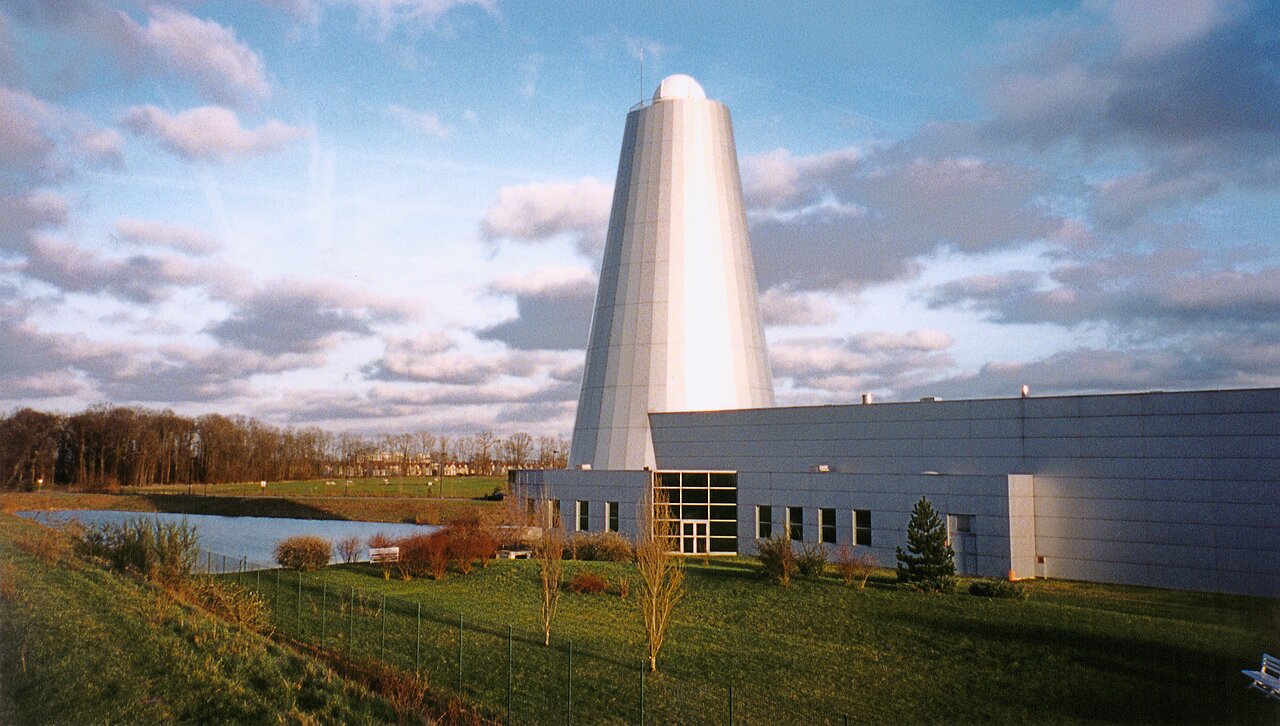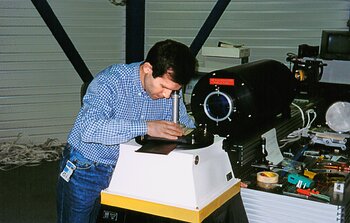Acceptance Test Results from first Gemini M1 Mirror
February 4, 1998

REOSC Optique has just completed acceptance testing of the first Gemini primary mirror, with excellent results. Larry Stepp witnessed the tests at REOSC from January 12-23, and was impressed by their thoroughness. The Gemini Project has benefited from REOSC's experience with the first three ESO VLT primary mirrors, but the Gemini specifications required additional tests beyond those required by ESO.
Dimensional measurements confirmed that REOSC has maintained the geometric accuracy of the blank as generated by Corning. The rotational symmetry of the blank is excellent. The mirror is slightly thicker (+ 0.3 mm) than specified, and the bevels are slightly narrower (- 1 mm) than specified but neither of these will cause any problem.
REOSC performed a linear Hartmann test in two directions (along both the X- and Y-axes). The results were very encouraging:
- The conic constant determined by the Hartmann test and the conic constant determined by interferometry agree to within 84 parts per million. The measured conic constant of the mirror deviated from nominal by 150 ppm, compared to the tolerance of 500 ppm. (The range of adjustment of conic constant by the active support system is several thousand ppm.) The Hartmann test is a direct ray tracing test that does not require any null correctors, fold mirrors or other auxiliary optics. The agreement between the Hartmann test and interferometry guarantees the Gemini primary mirror does not suffer from a conic constant mismatch, which has been a problem on many other telescopes including the Hubble Space Telescope.
- The Hartmann test confirmed the radius of curvature measurement within 3 mm. The measured radius of curvature of the mirror is 28,805 mm, 5 mm longer than nominal. This is well within the tolerance for the radius of curvature, which is 30 mm.
- The Hartmann test also confirmed the optical surface is centered on the geometrical dimensions of the mirror within about 0.7 mm, well within the +/- 1 mm specified. This is unusually good, and reflects the accurate generating work done by Corning as well as good process control at REOSC.
REOSC performed full-aperture and sub-aperture interferometry to measure the surface figure of the mirror. Careful design of the test and careful control of test parameters minimized the measurement errors, but all error sources identified by either REOSC or Gemini staff were quantified, and their effect included in the evaluation of the mirror figure. Therefore we have high confidence that the following interferometry results are conservative:
The intrinsic mirror surface figure is better than 16 nm RMS. (""intrinsic"" means the polishing error alone, that is, the mirror figure on a perfect mirror support).
- The maximum peak-to-valley range is 141 nm. (If the mirror were the diameter of the earth, the largest bump on it would be less than one foot high.)
- The mirror is diffraction limited at visible (and longer) wavelengths.
- The bottom line is, this is the best mirror of its size ever polished.
REOSC evaluated the point spread function of the image produced by the mirror, with the following results:
- The mirror meets all the Gemini encircled energy specifications. This includes specifications at 2.2 micron and 550 nm wavelengths. The more difficult specification is at 550 nm, where we required 80% of the light within a diameter of 0.1 arc sec. Including a correction for high-frequency errors measured with sub-aperture interferometry, and corrections for possible measurement errors, calculations show the mirror will concentrate 80% of the light within 0.079 arc sec at a wavelength of 550 nm. As far as we know, there is no other mirror of any size that can do better than this.
- The point spread function meets the difficult Gemini specification for satellite images at all specified wavelengths (500-3000 nm). The highest peak in the diffraction pattern around the central image at the most difficult wavelength is only 30% of the allowed amplitude.
Inspections of a number of areas (chosen by Gemini) with a Nomarski microscope showed the polished surface roughness varied from about 15 angstroms RMS near the center to about 18 angstroms RMS at the outer edge. All measurements were better than the specification, which is 20 angstroms RMS.
The Gemini specifications allowed REOSC to vary the support forces from their nominal values by up to +/- 100 newtons. The test results described above were accomplished with a support pattern that varied from nominal by less than +/- 70 newtons.
In summary, we are extremely pleased with REOSC for producing such an outstanding mirror, and we look forward to the completion of the second Gemini M1 this fall. With luck it may be even better.

